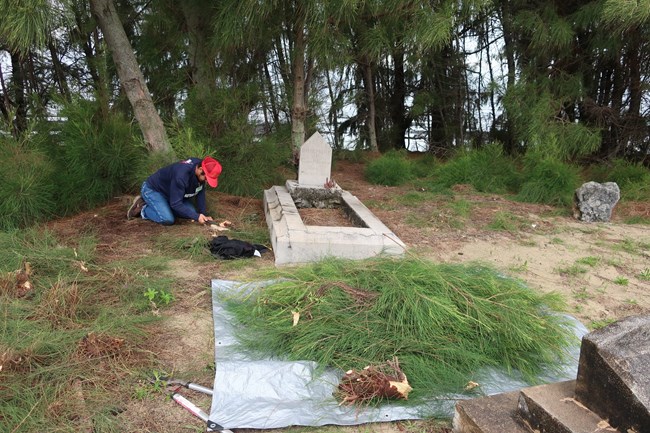Last updated: April 7, 2025
Article
HOPE comes to Kalaupapa

National Park Service
Natural Prison
The Kalaupapa Peninsula has been called a “natural prison”, with rough and rocky ocean on three sides and 2000 feet vertical cliffs on the fourth side. This made for an ideal location to quarantine leprosy patients starting in 1866. Patients were not officially allowed to leave until 1969, when the State board of Health repealed the isolation policy. Even though after 1969 residents of the peninsula could come and go as they please most decided to remain at the home and community they had made in Kalaupapa and still reside there today.
Unmarked Graves
Of the 8000+ patients that were forcibly sent to the Kalaupapa peninsula only approximately 2000 marked graves remain. The lack of marked graves are due to a variety of past issues. Many of the earliest graves were unmarked in accordance with traditional Hawaiian burial customs. However, one of the largest losses for markers is the tidal wave that hit the island in 1946. The tidal wave made landfall at the Papaloa Cemetery.

National Park Service
Another reason that grave markers have been lost is one of the factors that make many of the markers so unique.
Handmade Cast Concrete Grave Markers
A majority of the markers on Kalaupapa are handmade cast concrete markers. These were made with materials that the patients had on hand; concrete, beach sand, and scrap metal used as reinforcement in the casting.
There are two common styles of cast headstones.
-
The first is the stone was cast in a wooden mold (the wood grain can still be seen) and the epitaph pressed or carved into the wet concrete.
This style has held up well with the exception of the expanding scrap ferrous metal that is usually included in the casting.
-
The second style is a cast concrete form that has a very fine skim coat (looks to be pure concrete with no added aggregate) over the face.
The epitaph is then stamped or carved into this thinner layer. Unfortunately, without an aggregate to help the concrete to key into itself the epitaph layer develops cracks and eventually fails.

National Park Service

National Park Service
Graves Tell a Story
When the National Park was established in 1980 the Kalaupapa’s Patient’s Council said they felt the remaining grave markers were extremely important artifacts that were essential in telling the story of Kalaupapa.
To help with this NCPTT has partnered with the National Trust’s HOPE Crew and the University of Hawaii at Hilo.
From March 8-21, 2020 NCPTT’s Chief of Technical Services, Jason Church along with Cemetery Conservator James “Rusty” Brenner of Texas Cemetery Restoration lead a HOPE Crew project at Kalaupapa National Historical Park.
The goal of this project was to hand clean every grave maker and memorial on the peninsula.
To do this HOPE Crew Project Coordinator Molly Baker recruited University of Hawaii, Hilo professor Kerri Inglis. Professor Inglis brought fourteen of her students to the project.

National Park Service
Nearly 2,000 Markers & Memorials Cleaned
In the two weeks at the Park the students did extensive invasive vegetation removal. This is in addition to hand scrubbing all existing markers and memorials totaling close to 2000.
These varied in size from small flat markers to large lime stuccoed lava rock tombs.
For the cleaning process:
- Each of the markers was pre-wet with water. Since none of the cemeteries have running water, five gallon backpack sprayers were used.
- The markers were then sprayed with D/2 Biological Solution.
- The cleaner was allowed to dwell on the markers for around 10-15 minutes before hand scrubbing with natural bristle brushes;
- and finally rinsed off.
Some of the grave markers are carved from basalt. The biological growth on the basalt was more tenacious than on any other material. It was found that pretreating the basalt markers with D/2 a day or more before the scrubbing really helped remove this more tenacious growth.

National Park Service
Research of Patients
In addition to learning the basics of cemetery care the students had researched many of the former patients. A variety of patients were chosen to research some of them included artists, song writers, and authors such as Olivia Breitha and Cathrine Puahala.
Some were internationally famous such as Father Damien and Richard Marks.
Many of the people researched were family members. These students were not only contributing to the preservation of a historical site but were connecting with their own ‘ohana.
